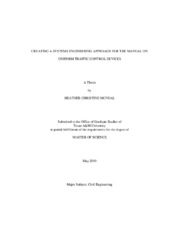| dc.description.abstract | The Manual on Uniform Traffic Control Devices (MUTCD) establishes the basic principles for the design, selection, installation, operation, maintenance, and removal of traffic control devices (TCDs). The MUTCD indicates that some TCDs that are required and some are recommended, depending on the situation. However, most TCDs are not required and the decision to use a given TCD in a given situation is typically made by an engineer (or an individual working under engineering supervision) based on a variety of information. Not all engineers have the same degree of experience in making TCD decisions, and not all engineers that make these decisions have traffic engineering expertise. There are many other factors not addressed by the MUTCD that can lead to differences in the decision-making process. To assist engineers with evaluating these factors, this research developed a decision analysis process to assist engineers with making TCD decisions.
The value of this research is the idea that the decision analysis process for TCD can be modeled and analyzed using appropriate factors. The developed factors include need, impact, influence, and cost. The process developed in this research applies two elements to each factor. One element compares the importance of each factor among all the other factors, and the other incorporates the engineer's judgment into the TCD decision. The first element described uses a decision analysis method, analytic hierarchy process, to determine the weights for each factor, or coefficients, as applied generally to a TCD. The second uses a mixture of quantitative and qualitative engineering judgment to determine the degree to which the factor applies to the TCD situation, or situational variable. The output of this process was a utility value that can be compared to a scale and determine the installation value of the device. This process will contribute to more uniform decisions amongst all levels of experience in TCD decision-making. Additional research that could expand on this developed process would include data collection on typical importance values for each factor as applied to a TCD and on decision scales for specific TCD situations.
When applying this research, it is important to remember that it is not the intent of this process to remove engineering judgment. This is an important part of the process and should remain as such. | en |


